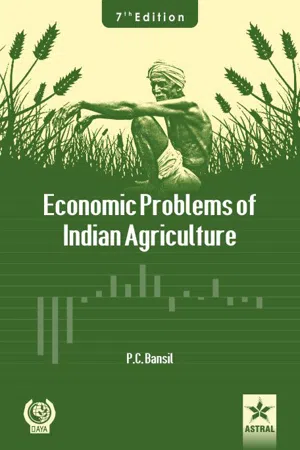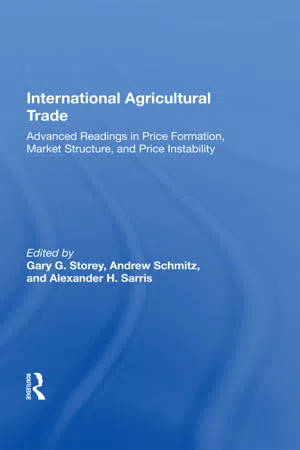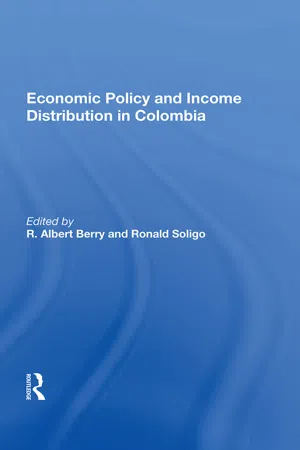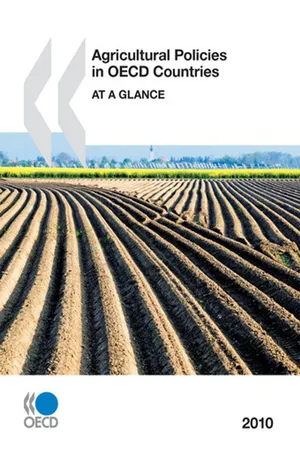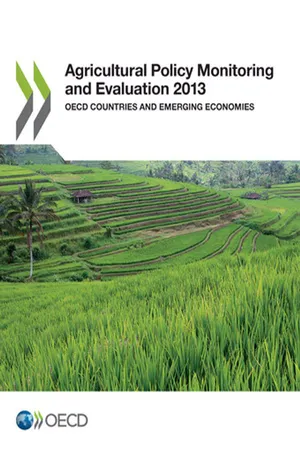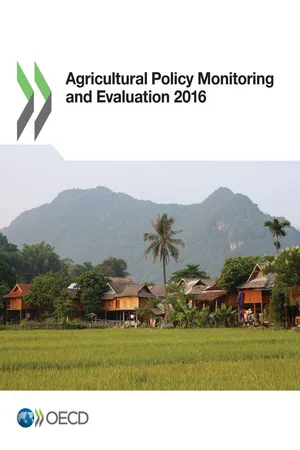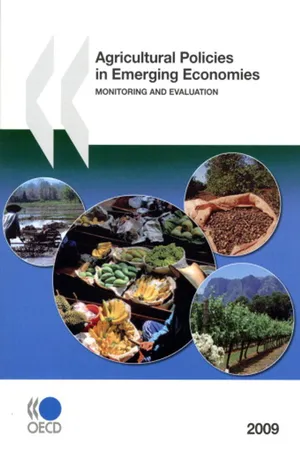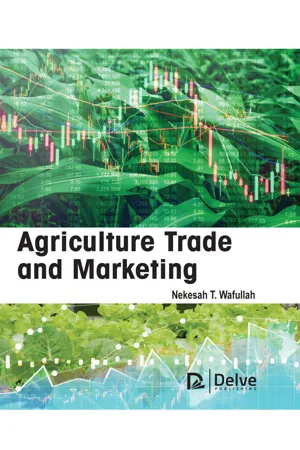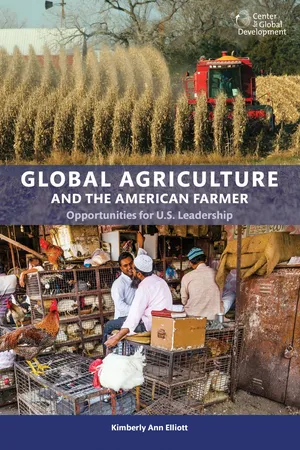Economics
Agricultural Price Supports
Agricultural price supports are government policies designed to stabilize and increase farm incomes by setting a minimum price for agricultural products. This is often achieved through mechanisms such as price floors, subsidies, and import tariffs. While intended to protect farmers from market fluctuations, price supports can lead to surpluses, distortions in production, and higher food prices for consumers.
Written by Perlego with AI-assistance
Related key terms
1 of 5
12 Key excerpts on "Agricultural Price Supports"
- eBook - PDF
- Bansil, P C(Authors)
- 2021(Publication Date)
- Daya Publishing House(Publisher)
Agricultural Price Policy aims at reducing the unduly large fluctuations in the prices of agricultural products, and the risk of loss to the producer would be minimized even in the event of an exceedingly good harvest. The policy of fixing the minimum guaranteed support prices can go a long way in creating a favourable climate for inducing the farmer to augment his investment in agriculture and to adopt improved technology. At the minimum support prices, Government undertakes to purchase all quantities offered to it so that the prices of agricultural produces do not fall below a specified level. The minimum support prices policy becomes essential in two ways; firstly it acts as a psychological incentive to the cultivator that his efforts in increasing production will not go in vain, and the level at which minimum prices are fixed also plays an important part in encouraging the farmer to undertake investment in improved technology. To reiterate the main objective of price policy for agricultural produce are aimed at ensuring remunerative price to the growers for their produce with a view to encouraging higher investment and production and to safeguard the interests of the consumers by marketing available supplies at reasonable prices. The price policy seeks to evolve a balanced and integrated price structure in the perspective of the overall needs of the economy. The National Commission on Agriculture (NCA), 1976 expressed that the agricultural price policy should keep in view its impact on the general price situation and on the economy as a whole. It should be in consonance with the country’s overall economic policy and facilitate growth with stability. The major aim of agricultural price policy should be to correct distortions which are in general socially or economically harmful and which emerged from time to time because of the imperfections of the market mechanism. - eBook - PDF
International Agricultural Trade
Advanced Readings In Price Formation, Market Structure, And Price Instability
- Andrew Schmitz, Gary Storey(Authors)
- 2019(Publication Date)
- CRC Press(Publisher)
Part II Market Structure and Institutions in International Agricultural Trade 5 Price Supports in the Context of International Trade Peter Berek and Andrew Schmitz INTRODUCTION Price supports have been commonplace in agricultural policy for the last five decades. Their effects have also been analyzed in several studies. For example, Wallace (1962), using a welfare economics framework, concluded that the price support programs proposed by Cochrane and Brannan lead to welfare losses. Omitted from Wallace's analysis, however, are important policy instruments such as acreage controls, and government-held stocks. Also, studies of the effects of price instability and the use of policy instruments to deal with it (for example, the early work by Massell) have major shortcomings in that they only incorporate storage policies as policy instruments; also these studies exclude price uncertainty. Lastly, Schuh (1974), shows how an overvalued exchange-rate influences the need for government policies such as price supports (e.g., an overvalued exchange rate reduces farm income since prices are depressed; hence, the need for price supports). This analysis, however, does not consider how the growth in the export component of U. S. agriculture can affect the choice and effectiveness of domestic policy instruments aimed at supporting farm income. This paper develops a model which incorporates price supports in an uncertain environment. The international trade sector is incorporated explicitly as are such policy instruments as farmer-held reserves. We demonstrate that the choice of policy changes as the volume vrhich a country exports expands. Peter Berek and Andrew Schmitz, Department of Agriculture and Resource Economics, University of California, Berkeley. 127 128 A THEORETICAL FRAMEWORK Traditional evaluations of agricultural stabilization programs do not clearly distinguish between decisions taken before and after the state of nature is known. - R. Albert Berry(Author)
- 2019(Publication Date)
- Routledge(Publisher)
S. Department of Agriculture, Economic Research Service, Technical Bulletin 1384, November 1967. 2 1. T. Bonnen, The Distribution of Benefits from Selected U.S. Farm Programs, Rural Poverty in the United States: A Report of the President's National Advisory Commission on Rural Poverty (Washington, D. C., 1967), pp. 461-505. 3 c. L. Schultze, The Distribution of Farm Subsidies, A Staff Paper (Washington, D. C.: The Brookings Institution), 1971. 4 R. M. Lidman, ''The Distribution of Benefits of Major Agricultural Programs (Unpub-lished Ph. D. dissertation, University of Wisconsin, 1972). CONSEQUENCES OF Agricultural Price Supports 205 tribution arising from price supports followed by a brief description of the data. The counterfactual question posed is which income groups would benefit and which would lose if domestic crop prices were brought into line with either un-adjusted or adjusted international values? Since abandonment of the price support program (though not necessarily its stabilization aspects) would involve a change in the efficiency of resource allocation, this effect is analyzed in a subsequent sec-tion. A final section summarizes the results and discusses some indirect effects of price supports which must be considered in an overall evaluation of such programs. 2. THE DEVELOPMENT OF COLOMBIAN PRICE SUPPORTS Protection of Colombian agriculture dates from the depression of the 1930s when tariff legislation was introduced which sharply raised import duties on all agri-cultural products. 5 Subsequently, rigid import quotas were applied to basic food-stuffs both during and after World War II. In 1944 a semi-official marketing agency, INA (Instituto Nacional de Abastecimiento), was established for the purpose of setting minimum prices for rice, com, beans, and wheat. As part of an overall im-port substitution strategy of economic development, the avowed goal of INA was self-sufficiency in agricultural production.- eBook - PDF
- OECD(Author)
- 2010(Publication Date)
- OECD(Publisher)
Multilateral 1. EVALUATION OF SUPPORT AND POLICY DEVELOPMENTS OECD AGRICULTURAL POLICIES IN OECD COUNTRIES 2010: AT A GLANCE © OECD 2010 37 negotiations, in the form of the Doha round, have not yet yielded agreement and require new momentum. Bilateral and regional trade agreements, while sometimes dealing with complicated issues such as sanitary and phyto-sanitary regulations and non-tariff barriers, often limit liberalisation for sensitive agricultural products. The rapidity of growth in agricultural commodity prices in 2007 led to concerns about the impact on consumers and the sufficiency of food supplies in the face of growing global demand. The fall in prices at the end of 2008 led once again to concerns about the sufficiency of food supplies due to pressure on farm income and profitability. It seems to be the case that the problem is not only that prices are too high or too low, but rather rapid changes in prices that mobilise protest and put pressure on policy makers to act while testing the ability of the food system to respond. Some countries put considerable effort into reducing price risk faced by producers, typically by compensating for low prices or income. Similarly, some countries insulate their consumers from price variability through the use of export or price controls. These efforts contribute to higher price variability in world prices as these countries “export” their price variability abroad. Furthermore, price stabilization is not always capable of reducing famers’ revenue and income variability, and its distributional and overall welfare impacts depend on the source of the price variability. Effective risk management policies need to assess the different sources of risk affecting farmers or consumers and apply diversified Figure 1.17. Composition of General Services and Support Estimate by country, 2007-09 Percentage share of GSSE Note: Countries are ranked according to the percentage shares of Research and Development. - OECD(Author)
- 2015(Publication Date)
- OECD(Publisher)
Assistance may be provided by supporting market prices, or by giving a subsidy to reduce the cost of inputs; support may take the form of a payment per hectare, per animal, or as a top-up to farmers’ income. Support may be given under the condition that farmers are actually engaged in Figure 1.10. Producer Support Estimate by country, 1995-97 and 2012-14 Percentage of gross farm receipts Note: Countries are ranked according to 2012-14 levels. 1. EU15 for 1995-97; EU27 for 2012-13; and EU28 from 2014 when available. 2. For Mexico, 1995-97 is replaced by 1991-93. 3. The OECD total does not include the non-OECD EU member states. The Czech Republic, Estonia, Hungary, Poland, the Slovak Republic and Slovenia are included in the OECD total for all years and in the EU from 2004. Source: OECD (2015a), “Producer and Consumer Support Estimates”, OECD Agriculture Statistics (database), http:// dx.doi.org/10.1787/agr-pcse-data-en . 1 2 http://dx.doi.org/10.1787/888933234348 1995-97 2012-14 % -20 -10 0 10 20 30 40 50 60 70 80 Norway Switzerland Japan Korea Iceland Turkey Indonesia European Union 1 China Colombia Kazakhstan Mexico 2 Russian Federation Canada Israel United States Brazil Chile South Africa Australia New Zealand Ukraine OECD 3 1. DEVELOPMENTS IN AGRICULTURAL POLICY AND SUPPORT AGRICULTURAL POLICY MONITORING AND EVALUATION 2015 © OECD 2015 42 production, or without such a condition. Payments can be conditional on the respect of specific production practices. These distinctions are important as support delivered in these various ways has different impacts on agricultural production, trade and incomes. Also, some forms of support are more suitable for targeting to specific objectives and beneficiaries. For example, support based on farming area, animals kept, or farm income can be targeted to specific farms or locations, and the amount of outlay can be tailored to the problem at hand. In contrast, blanket price support cannot discriminate between beneficiaries.- OECD(Author)
- 2013(Publication Date)
- OECD(Publisher)
The support of farm incomes is among the policy objectives in a number of countries. Policy objectives are, however, much more diverse than that, and often include the correction of various market failures referring to the environmental, rural amenities, land and water management, food safety and food security (OECD, 2002). Policy priorities have also been expressed by Ministers of Agriculture at their OECD Meeting in 2010, including measures to mitigate and cope with high and volatile prices potentially threatening food security in many countries and requiring risk management tools; climate change calling for both mitigation and adaptation strategies; increasingly scarce resources such as land, water and biodiversity. Agricultural and rural development policies need to be coherent with policies in other areas, and unintended effects require greater attention. Current high agricultural prices and medium term expectations of continued high prices provide opportunities and challenges for policy adjustments. With high prices, the rationale for price support has weakened, and at a period of fiscal consolidation in numerous countries, budgetary transfers to all farms independent of their financial situation and unrelated to their provision of public goods (or the avoidance of public bads) appears to be an inefficient use of scarce financial resources. Policy priorities differ across countries and, in many cases, are specific to particular regions or groups of farms. One-size-fits-all policies will be inappropriate to deal with specific challenges, and even more so across different countries. Instead, policy objectives need to be carefully translated into targeted measures.- OECD(Author)
- 2016(Publication Date)
- OECD(Publisher)
Paris, www.oecd.org/tad/agricultural-policies/40477848.pdf. OECD (2001), Market Effects of Crop Support Measures, OECD Publishing, Paris, http://dx.doi.org/10.1787/9789264195011-en. Victor, D.G. et al. (2014), “Climate Change 2014: Mitigation of Climate Change 2014”, Contribution of Working Group III to O. Edenhofer et al. (eds.), Fifth Assessment Report of the Intergovernmental Panel on Climate Change, Cambridge University Press, Cambridge and New York, www.ipcc.ch/pdf/assessment-report/ar5/wg3/ipcc_wg3_ar5_chapter1.pdf. World Bank (2016), Commodity Markets Outlook Q1, The World Bank, Washington DC, www.worldbank.org/en/research/commodity-markets. World Trade Organisation (2015), Nairobi Package, Geneva, www.wto.org/english/thewto_e/minist_e/mc10_e/nairobipackage_e.htm. Notes ← 1. China, Colombia, Iceland, Indonesia, Israel, Japan, Kazakhstan, Korea, Norway, the Russian Federation, Switzerland and Turkey provide market price support. Indonesia and Mexico subsidise energy and fertilisers. Brazil, Colombia, Kazakhstan and the Russian Federation provide concessional credit to stimulate agricultural investments. ← 2. The Total Support Estimate (TSE) is the broadest indicator of support. It combines transfers to agricultural producers individually (measured by the Producer Support Estimate, the PSE), policy expenditures that have primary agriculture as the main beneficiary, but that do not go to individual farmers (measured by the General Services Estimate, the GSSE) and budgetary support to consumers of agricultural commodities (the Consumer Support Estimate, CSE, net of the market price element that is already accounted for in the PSE).- eBook - PDF
Automatic Government
The Politics of Indexation
- R. Kent Weaver(Author)
- 2010(Publication Date)
- Brookings Institution Press(Publisher)
The rationale for the program shifted for peacetime: price supports were justified as stabilizing incomes for farmers and prices and supply to consumers—each, admittedly, at higher levels than would otherwise be the case. The act gave the sec-retary of agriculture responsibility for setting price supports between 75 percent and 90 percent of parity. 2 In theory, this allows the secre-tary to respond to changing market conditions. In practice, the secre-tary has usually set the price at the minimum allowed by Congress. Although the secretary's range of discretion over the support price was altered from time to time, the program established in 1949 remained basically unchanged for the next thirty-two years. Political Alignments The dairy industry faces two important constraints in defending its program. First, it is concentrated regionally. While all states have some dairy production, five states produce 50 percent of the country's milk, and ten states produce two-thirds of it. 3 Over half of all dairy produc-tion comes from forty-four congressional districts. 4 Second, the num-ber of commercial dairy farms has declined dramatically, from 600,000 in 1959 to 200,000 in 1978, as herd size per farm has gone up and both farm workers and cows have become more productive. 5 1. The 1910-14 period was chosen because it represented a prosperous period in the history of American agriculture. On the development of the parity concept, see Wesley McCune, The Farm Bloc (Garden City, N.Y: Doubleday, Doran and Co., 1943) , chap. 2. 2. On the wartime provisions and development of the 1949 act, see Congressional Quarterly Almanac, vol. 5 (1949), pp. 131-46. See also John D. Donahue, The Political Economy of Milk Atlantic Monthly (October 1983), pp. 59-68; and Congressional Quarterly, Farm Policy: The Politics of Soil, Surpluses, and Subsidies ( Washington, D.C.: CQ, 1984). - eBook - ePub
International Trade Policy
A Contemporary Analysis
- Nigel Grimwade(Author)
- 2006(Publication Date)
- Routledge(Publisher)
aggregate measurement of support (AMS) and apply to all domestic support policies except those given specific exemptions. The latter are defined as supports ‘not involving transfers from consumers’ but ‘provided through a publicly funded government programme’ and which do not ‘have the effect of providing price supports to producers’. These include such policies as: general government services (in areas such as research, pest and disease control, and so on); public stockholding for food security purposes; domestic food aid; direct payments to producers; ‘decoupled’ income support (that is, support not related to or based on production); structural adjustment assistance; payments under environmental programmes; and payments under regional assistance programmes.In addition, measures of assistance to encourage agricultural and rural development in developing countries, investment subsidies in developing countries and agricultural input subsidies to low-income or resource-poor producers in developing countries are exempt from domestic support reduction commitments. Other support which makes up a low proportion of the value of production (up to 5 per cent in a developed country and 10 per cent in a developing country) and which otherwise would be included in the calculation of a country’s AMS can be omitted. Finally, direct payments under production-limiting programmes are not subject to the reduction commitment.Total AMS is to be reduced by 20 per cent (13.3 per cent in the case of developing countries) over a six-year period (ten years for developing countries) commencing in 1995. AMS is defined as ‘the annual level of support, expressed in monetary terms, provided for an agricultural product in favour of the producers of the basic agricultural product or nonproduct-specific support provided in favour of agricultural producers in general, other than support provided under programmes that qualify as exempt from reduction’.Export subsidies
These are defined as ‘subsidies contingent upon export performance’. Developed countries must reduce the value of export subsidies to a level 36 per cent below the 1986–90 base period and the quantity of subsidised exports by 21 per cent over the six-year implementation period. The reductions for developing countries are two-thirds those of developed countries and cover a ten-year period, with least developed countries being subject to no reductions at all. Developing countries are also not required to undertake commitments in respect of subsidies to reduce the costs of marketing exports of agricultural products and the provision of favourable internal transport and freight charges on export shipments. Where subsidised exports have increased since the 1986’90 base period, 1991’2 may be used as the starting point of reductions, but the end point remains that based on the 1986’90 base period level. There is some flexibility allowed in implementing the reductions, this may mean that, under strict conditions, the level of export subsidies in any one year can exceed the annual commitment levels. - OECD(Author)
- 2009(Publication Date)
- OECD(Publisher)
ANNEX A AGRICULTURAL POLICIES IN EMERGING ECONOMIES 2009: MONITORING AND EVALUATION – ISBN 978-92-64-05927-6 – © OECD 2009 167 ANNEX A Measuring Agricultural Support 1. Definitions of OECD indicators of agricultural support Nominal indicators used in this report* Producer Support Estimate (PSE): the annual monetary value of gross transfers from consumers and taxpayers to agricultural producers, measured at the farm gate level, arising from policy measures that support agriculture, regardless of their nature, objectives or impacts on farm production or income. It includes market price support, budgetary payments and budget revenue foregone, i.e. gross transfers from consumers and taxpayers to agricultural producers arising from policy measures based on: current output, input use, area planted/animal numbers/receipts/incomes (current, non-current), and non-commodity criteria. Market Price Support (MPS): the annual monetary value of gross transfers from consumers and taxpayers to agricultural producers arising from policy measures that create a gap between domestic market prices and border prices of a specific agricultural commodity, measured at the farm gate level. MPS is also available by commodity. Producer Single Commodity Transfers (producer SCT): the annual monetary value of gross transfers from consumers and taxpayers to agricultural producers, measured at the farm gate level, arising from policies linked to the production of a single commodity such that the producer must produce the designated commodity in order to receive the payment. This includes broader policies where transfers are specified on a per-commodity basis. Producer SCT is also available by commodity. Consumer Single Commodity Transfers (consumer SCT): the annual monetary value of gross transfers from (to) consumers of agricultural commodities, measured at the farm gate level, arising from policies linked to the production of a single commodity.- eBook - PDF
- Nekesah T. Wafullah(Author)
- 2023(Publication Date)
- Delve Publishing(Publisher)
Many other countries’ pricings have been changed by government initiatives. Although government programs and regulations have not been totally abandoned, there has been a tendency toward reduced price-support levels and less trade barriers since the beginning of the 1990s. A potential challenge in evaluating the behavior of commodity prices through time is the changing type and role of government programs. It is critical to remember that price decisions, whether based on market forces or political considerations, have significant economic implications. As a result, analytical methods that can help predict the economic consequences of changes in government programs or private-sector decisions are still crucial. Farmers, marketing, and supply companies, and government officials must make several decisions that involve knowledge of what will happen if a commodity’s price rises or decreases. For example, meat packers want to know how much hog production will change in reaction to hog prices or, more importantly, hog prices relative to corn prices. Government officials need to know how changes in price-support levels will affect domestic use, exports, and production. Apple storage companies want to know how putting more apples in controlled-atmosphere storage, which extends the storage life of produce, would affect late-season costs. Prices students can assist in answering such inquiries. 4.4. APPROACHES TO AGRICULTURAL PRICE DETERMINATION The process of calculating the cost of goods sold (COGS) and services supplied to the market is known as price determination. Price decisions can be made based on a variety of criteria, including cost, demand, competition, value, or a combination of factors. While many marketers are aware that these elements should be considered, pricing remains somewhat of an art. We categorize the alternative techniques of establishing pricing as follows for discussion purposes: - No longer available |Learn more
Global Agriculture and the American Farmer
Opportunities for U.S. Leadership
- Kimberly Ann Elliott(Author)
- 2017(Publication Date)
- Center for Global Development(Publisher)
Agricultural policy reform must remain on the development agenda because trade is a key tool to alleviate poverty and to bring food security to an estimated 800 million people around the world who remain chronically undernourished. Better policies to make agriculture in developing countries more productive and profitable, including via exports, would help achieve both these goals. Stronger international trade rules would help by constraining the beggar-thy-neighbor policies that distort trade, contribute to price volatility, reduce confidence in global markets, and discourage investments in developing country agriculture. American farmers that rely on export markets would also benefit from more effective disciplines on agricultural subsidies and trade barriers. Agriculture may not be new on the trade agenda, or as sexy as e-commerce, but it is still important.1 . Elliott (2015a).2 . Anderson, Rausser, and Swinnen (2013, figure 2).3 . OECD (2016, p. 44).4 . Ibid., p. 42.5 . For a detailed review of agricultural policies in the EU and other selected OECD countries, including the United States, see European Parliament (2012). Anderson, Rausser, and Swinnen (2013) explore the trends in agricultural support and the political economy of reform.6 . Bureau, Laborde, and Orden (2013).7 . CGD Working Group on Global Trade Preference Reform (2010); and Elliott (2014).8 . See Hendrix and Kotschwar (2016) for analysis of the TPP agreement on agriculture.9 . Elliott (2016).10 . See Elliott (2006, pp. 17–18), for a brief summary of the agreement, and see the WTO website on “The Uruguay Round reform programme for trade in agriculture” for more detailed information: www.wto.org/english/tratop_e/agric_e/ag_intro00_contents_e.htm.11 . Many countries—and not just poorer ones—do not fulfill these obligations on a timely basis. Moreover, the vagueness of the rules in many cases makes the economic impact of the data in the notifications difficult to interpret. For analysis of key countries’ compliance with WTO commitments, including questionable measures that are not reported to the WTO, see Orden, Blandford, and Josling (2011).12 . The OECD (2016, p. 47) defines the most distorting supports as market price support (typically enforced through trade barriers), payments linked to commodity output, and unconstrained payments for variable input use, such as energy subsidies.13 . Orden (2013, p. 9); see also Bureau, Laborde, and Orden (2013, pp. 62–66).14 . See page 6 of the OECD report at www.oecd.org/tad/agricultural-policies/USA_cookbook.pdf (accessed November 3, 2015).15 . European Parliament (2012, p. 93).16 . Anderson, Raausser, and Swinnen (2013, p. 30).17
Index pages curate the most relevant extracts from our library of academic textbooks. They’ve been created using an in-house natural language model (NLM), each adding context and meaning to key research topics.
